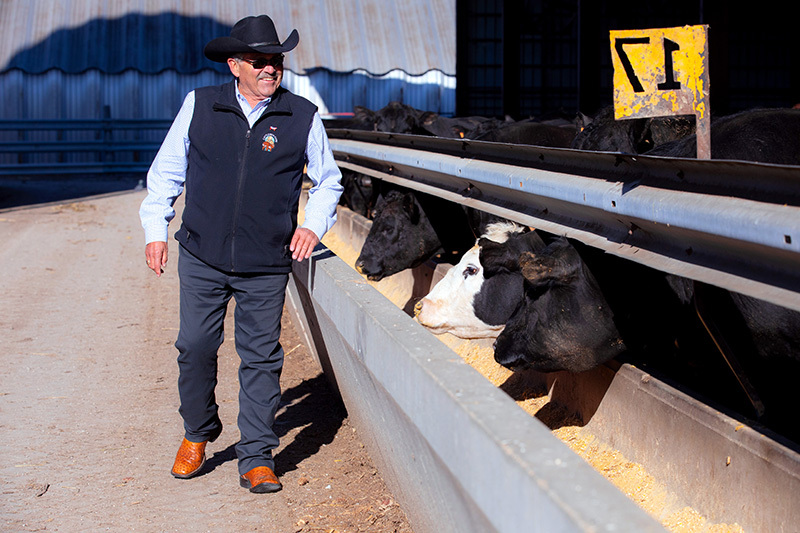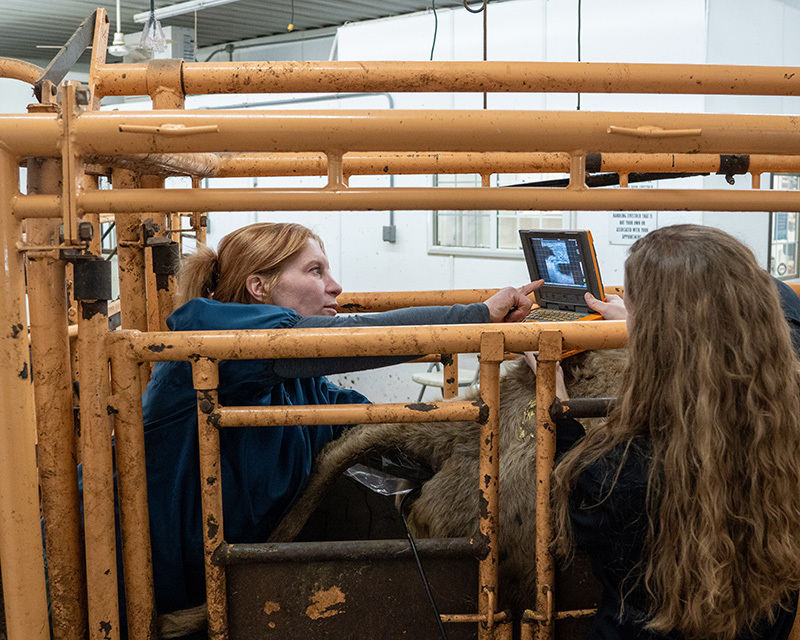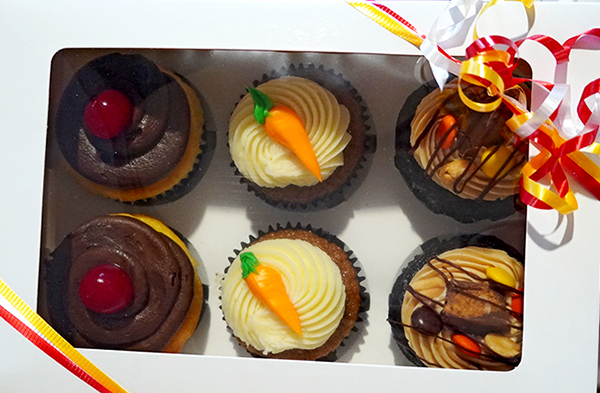Editor's note: This feature is the fourth in news service's 2024 Innovation at Work series of stories, photos and videos that highlight economic development and the impact of Iowa State's contributions across the state. A new entry will post every Tuesday through April 23.

Bill Couser walks past cattle at his feedlot near Nevada. Photo by Christopher Gannon.
Mike Paustian raises hogs in eastern Iowa, where his family has farmed for six generations. At their home farm, tucked behind the Iowa 80 truck stop near Walcott, his parents still live in the house his great, great, great grandfather built.
Paustian Enterprises remains a family-run, farrow-to-finish operation. Pigs are bred, born and fed to market weight on corn they grow and mill, a crop fertilized by the hogs' manure. It's a traditional self-contained cycle of swine production, enhanced by contemporary practices such as solar power and cover crops. The Paustians are always looking for ways to improve, and Iowa State's Veterinary Diagnostic Laboratory (VDL) is indispensable in that quest.
"I can't overemphasize how important the Veterinary Diagnostic Lab is to our farm. Just as we have taken advantage of new technologies, the VDL has been doing the same thing. We've grown together, in many ways," Mike Paustian said. "If we didn't have the resources at the VDL to understand what's going on in our herd, I don't think raising pigs would be nearly as fun or profitable. We'd constantly be chasing our tails."
As the VDL enters a new era -- opening the first portion of a two-phase, $141.5 million facility designed to handle the mounting caseloads of the present and unknown challenges of the future -- fellow clients who rely on the lab echo Paustian's sentiments. The VDL's speed, expertise and devoted service make it an essential partner for livestock and poultry producers, the behind-the-scenes foundation of one of Iowa's most important industries.

Dr. Jodie Pettit performs an ultrasound on a cow in the large-animal unit of AMVC's Audubon clinic. Photo by Sophie Hansen.
Million-dollar decisions
In her 23 years in practice at the Audubon-based AMVC Veterinary Services, Dr. Jodie Pettit has seen most of the company's expansion over three decades from a small-town veterinary clinic to one of the country's largest swine management operations. AMVC manages 45 farms across 11 states, overseeing about 163,000 sows. That dramatic transformation wouldn't have happened without the VDL, said Pettit, one of the company's 17 partners and a mixed-animal veterinarian at the original clinic in Audubon.
"It's pivotal for us. We have been able to grow at the rate we have because we have access to a world-class lab," she said. "We're making million-dollar decisions multiple times a day based on whether it's safe to move animals to, say, a large sow barn. You're risking all the animals already at the barn every time you open the door to new arrivals."
With farms across the country, AMVC has worked with numerous diagnostic labs, Pettit said. Iowa State's VDL, which handles the nation's largest food animal caseload, easily stands out as the best. Part of that is speed, a major emphasis of VDL operations. A couple of examples Pettit cited: The lab's self-built software provides clients access to test results as they come in, and certain herd monitoring tests offer same-day results.
The VDL's commitment to customer service also sets it apart, Pettit said. The lab's faculty and staff understand what's riding on their work, she said.
"Everybody is on pins and needles when we're moving animals. The truckers are waiting. The truck wash is waiting. The people unloading and loading on both ends are waiting. It's really a time crunch to get those answers back," she said. "To say the VDL is customer-oriented is a major understatement. They truly go above and beyond. If they need to, they stay late to make sure those movements are possible. They understand what we in the trenches are going through."
'They operate the way we do'
Or to put it the way Dr. Craig Rowles says it: "They run that lab like we run our businesses. This is not just an 8-5 job. They operate the way we do as producers."
Video
Iowa farmers find critical partner in Veterinary Diagnostic Lab.
Rowles started out as a large-animal veterinarian in Carroll, tending mostly to cattle and hogs. He later moved into hog production and now is in the third act of his career in animal agriculture, as director of cage free operations for Versova. The Iowa-based company manages 40 million layer hens across farms in Iowa, Ohio, Washington, Oregon and Utah.
He recalled an incident at a farm in Ohio that showed the skill and devotion of the Iowa State VDL. Versova got word that a mistake at a different company's packing plant may have exposed an entire flock of hens to an antibiotic that could leave a residue in their eggs. He made a panicked Saturday morning call to the lab's director, Dr. Rodger Main. As-soon-as-possible results on an emergency toxicology screening on a weekend was a big ask, Rowles figured.
"But Rodger said, 'Well, we can do that,'" Rowles said. Versova flew samples to Ames and by Sunday had proof their eggs were clean.
The lab was just as responsive during the recent years' highly pathogenic avian influenza outbreaks, despite surging demands, he said. Urgency is crucial because producers, veterinarians and government regulators rely on diagnoses to take action, slowing disease transmission and limiting economic implications. Minor delays can cause major impacts.
"I can't say enough about how prompt they are in the face of those challenges and how important that is," Rowles said.
Peace of mind
For Bill Couser, owner of a feedlot near Nevada with up to 5,200 beef cattle, the VDL is all about peace of mind. He trusts that with the lab nearby, he'll have access to answers if -- when, more likely -- a disease outbreak happens.
"Every livestock producer in Iowa is a partner with the diagnostic lab. It's a godsend for us all. We don't even think about it. Not that we take it for granted, but we know the work will be done. That lets you sleep easy at night," he said. "Most people have no clue what happens inside that lab or what it means. But the people who use it know the value it brings for Iowa and the world."
Couser's appreciation for the lab's importance was heightened years ago by a sudden rash of cattle deaths in his herd that turned out to be bovine respiratory syncytial virus.
"You'd watch them falling over in the pen, and your heart would just sink," he said. "Iowa State's near and dear to my heart because of how they got on top of that."
The lab has a history of scaling up to handle swelling testing needs and stepping up to solve novel problems, including its responses to porcine epidemic diarrhea, avian influenza and -- in partnership with the University of Iowa's State Hygienic Laboratory -- COVID-19. It was Iowa State researchers at the VDL, in collaboration with other state and federal agencies, who detected that a recent illness that's spread to dairy herds in six states is highly pathogenic avian influenza, the first known cases of the virus infecting cattle.
Preparation for the next challenge is always a focus. The new facility was designed with surge capacity in mind, and VDL researchers are studying high-throughput testing machines that use microfluidics to process 30,000 tests a day compared to a standard machine's 2,000.
It's a track record that inspires trust, Paustian said.
"They've shown over and over again that they can ramp up quickly to support producers in an emergency. I'm not losing any sleep over that," he said.
More data, healthier food
In fiscal year 2023, Iowa State's VDL processed more than 124,000 cases involving nearly 1.7 million individual tests. It marked the 13th consecutive year the lab's caseload has increased. The skyrocketing volume is driven more by disease prevention than identification. Improved methods for collecting and analyzing samples have led to a boom in population-wide health monitoring.
For instance, swine producers routinely submit saliva collected from a rope that pigs are provided to chew on and fluids collected from castrations, methods developed by Iowa State faculty who rely on the lab's stream of cases to conduct applied research and train students. Using surveillance testing to keep any eye on the health status of his herds allows Paustian to tweak vaccines and see emerging concerns.
"We're making more data-driven proactive decisions all the time. That gives us a lot of confidence that we'll have a stable flow of healthy pigs," he said.
More than 90% of the lab's cases come from animals being raised for food. About 75% of the overall cases are swine, which represented less than 60% of cases in 2010. At AMVC, Pettit said testing is so frequent that they have an employee whose job includes driving samples to Ames on a nearly daily basis.
Poultry operations also conduct extensive monitoring, such as regular environmental tests for salmonella required in egg-laying barns, Rowles said. That helps directly protect consumers, though in one way or another most of the lab's work is geared toward ensuring food safety and public health, he said.
"The VDL plays a role every single day in making sure the eggs, meat and dairy Iowans buy in grocery stores are the safest possible product we can provide," he said.
It's a given that livestock health surveillance will continue to grow, Paustian said. He envisions a day when the lab is analyzing automatically collected submissions, rapidly providing genetic sequencing of the entire sample.
"We're really just hitting the tip of the iceberg at this point," he said.
Building for the future
VDL faculty and staff began working in the completed portion of the lab's new facility late last month. The $75 million first phase is home to sections covering about 20% of the lab's services -- necropsy, pathology, histopathology and bacteriology -- and space for receiving, routing and preparing submitted samples. Construction begins later this month to expand the facility in a $66.5 million second phase that will house the other 80% of the lab's functions.
Faculty and staff have been packed tight in the building the lab has occupied for nearly 50 years, which is connected to the rest of the college's complex. In addition to the benefits of purposefully designed and expanded space, upgrading to a standalone structure with clear boundaries between public and private areas is a vast improvement in biosafety, Main said.
"Now we're in a building that was built to be a lab, not a lab built to be in a building," he said.
One of Pettit's favorite features of the new lab is the openness. There are numerous ways throughout the building to watch faculty and staff work, including large windows dividing public hallways from bustling private lab spaces.
"The public can walk by and look right in. With the drive to understand where food comes and how animals are raised, I think that's a huge step in the right direction to give consumers confidence in the science we're performing. I'm really excited it was built that way," she said.
Offering opportunities for observation was intentional, Main said. Putting the lab's science on display will help highlight its value, sharing with a broader audience what Iowa livestock and poultry producers already know so well.
"That will help educate the public, students and international trading partners about the really good story of Iowa and U.S. food animal agriculture and the role that modern medicine plays behind the scenes in supporting a safe and abundant food supply," he said.

